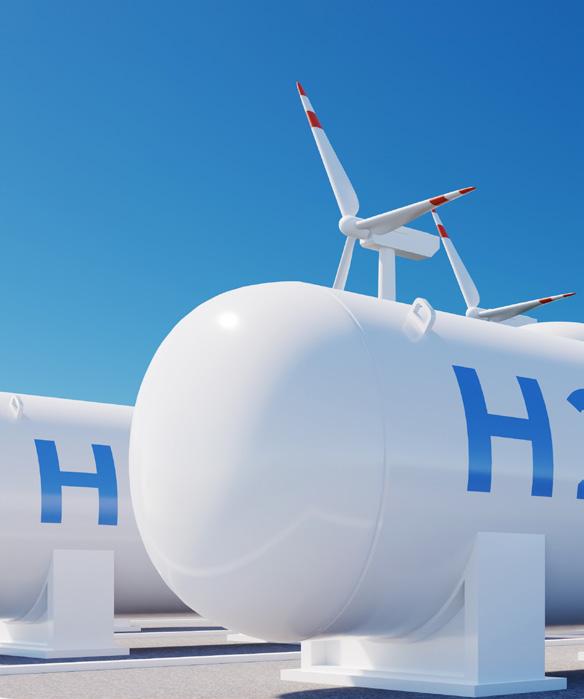

HYDROGEN
COMING UP







FOREWORD
“The costs of managing thermal constraints on the electricity transmission network are increasing year on year ”
Welcome to the latest edition of Hydrogen Industry Leaders, a magazine dedicated to the pioneers and visionaries shaping the future of the hydrogen economy. In this issue, we explore the innovations, challenges, and triumphs of an industry that stands at the forefront of the global energy transition.
In this edition, we delve into the latest technological advancements from hydrogen safety, to storage and distribution innovations. We also examine the policy frameworks and market dynamics driving investment and growth in hydrogen infrastructure worldwide.
Our featured articles highlight successful projects and collaborations that are setting benchmarks for the industry. We hear from leaders who are navigating the complexities of scaling up production and ensuring the sustainability of the hydrogen value chain. These stories of determination and ingenuity underscore the pivotal role of industry leaders in steering us toward a greener future.
Floyd March Editor f.march@peloton-events.co.uk
Hannah Wintle Multi Media Journalist
Paul Rose Graphic Designer
‘World’s First’ Sustainable Aviation Fuel Project to be Built at Saltend
HOW THESE TANGIBLE PROGRESS MEASURES CAN HELP DEVELOP THE HYDROGEN ECONOMY

Few local authorities have active hydrogen projects underway in their constituencies and even fewer can boast of projects the size of the Low Carbon Energy Park being developed in Trafford, Manchester.
The Trafford Low Carbon Energy Park is bringing together a trinity of developments, consisting of a green hydrogen production facility, Li-ion battery energy storage scheme and the liquid air storage plant in partnership with Highview.
Cllr Tom Ross, Leader of Trafford Council, expressed his excitement for the recent progress being made and making best use of existing infrastructure. “It is great to make such significant progress since the funding decisions were made at the end of 2023. It will not only have a huge impact in Trafford but also as part of the wider GM energy network and things we are doing from a green city region perspective.”

Tracking the progress of projects such as this can be difficult, especially when there is little in the way of comparison with previous ways of working.
TANGIBLE AND MEASURABLE IMPACTS OF PROGRESS EASE NASCENCY CONCERNS
From a constituent and industry perspective, firstof-a-kind and other new developments come with a myriad of questions, not least those asking how progress will be measured.
Tracking the progress of projects such as this can be difficult, especially when there is little in the way of comparison with previous ways of working.
James picked up on this difficulty by explaining: “There are emissions statistics produced every year by the government, but the challenge here is that they are always two years in arrears.”
“However, this information is still relevant to use, but you really have to dig and unpick to understand what the data is showing us. Correlation doesn’t always mean causation so we’ve got to be careful when drawing conclusions.
“We produce a broad swath of data that allows for people to see this type of data on a deeper scale.”
To do this, Trafford Council has the Trafford Data lab which allows for this data analysis and transparency. It can show what is happening on a quarterly level, the energy efficiency of homes, amount of EV installations etc.
That provides transparency and allows people across Trafford to understand what is happening and see the progress being made in this field. This is shareable with other local authorities which boosts the collaboration effort that is often coupled with growing a hydrogen economy.

EXISTING INFRASTRUCTURE MAKES THE NORTH WEST PARTICULARLY APPEALING
With this traditional difficulty overcome with the above practices, the use of existing infrastructure can help with space constraints.
On this, Trafford was highlighted as being particularly well located because the area has several industrial sites which are able to take green hydrogen without extensive modification to decarbonise their operations, which otherwise rely on natural gas.
Further to this, it is well placed to serve commercial and residential applications in central Manchester, once the project is scaled up and these applications become hydrogen ready.

The hydrogen produced by the initial 20 MW plant will reduce carbon dioxide emissions into the atmosphere in Manchester by over 14,000 tonnes annually.
Cllr Ross told Hydrogen Industry Leaders: “Joining projects like this together and focussing on the hydrogen aspect specifically, it really shows how dynamic thinking can push projects over the line and shows that Trafford, and Greater Manchester can create a blueprint for the rest of the country.
“This works with our wider strategies, we’ve got a current corporate plan with low-carbon technologies central to that. By summer 2024, we will bring additional aspects into the updated corporate plan.
“At a Greater Manchester level we are creating a local area energy plan, biodiversity and other areas where green hydrogen can be explored.”
The hydrogen produced by the initial 20 MW plant will reduce carbon dioxide emissions into the atmosphere in Manchester by over 14,000 tonnes annually.
TAPPING INTO GEOGRAPHICAL NUANCES SHOULD BE THE FIRST STEP TO DEVELOPING HYDROGEN
In a geographical sense, planning the location of such projects can be a minefield, but Greater Manchester’s good transport links, ample space and pre-existing infrastructure were key factors in the decision making.
James Harries, Head of Climate Change and Sustainability at Trafford Council added to this: “What’s interesting about Trafford is that it has a relatively unique emissions footprint when you look across the whole borough, and for most local authorities that you look at the key emission sources are domestic buildings and transport but for Trafford it is industry.
“Trafford Park itself accounts for over half of our industry emissions for the whole borough. Decarbonising this area is integral on our route to net zero.”
“If you look at the emissions profile across Greater Manchester, Trafford really stands out through its unique position.”
If this unique position can be capitalised on through the use of hydrogen; it could prove a benchmark for other more industrial regions of the UK, including the Humber, East Midlands and other areas in the North.
“It [hydrogen] is a really important part of a portfolio of decarbonisation measures, and the Trafford Park projects are a testament to that and the great collaboration we are seeing in the sector.”

“Hydrogen is more of a longer-term solution and strategy with the nascency of green hydrogen but that’s why the shorter and more medium-term technologies are just as important. Trafford Park catering for all these needs sets us in good stead for the future.”
Supporting a stronger rollout of green hydrogen involves looking at the low-hanging fruit of energy efficiency in the short term, then more mediumterm support with solar PV and more technologydriven measures.
At this point hydrogen can play a much larger and targeted role alongside other technologies such as deep thermal and the work Trafford is doing has the same technology pathway.
It [hydrogen] is a really important part of a portfolio of decarbonisation measures, and the Trafford Park projects are a testament to that and the great collaboration we are seeing in the sector.
In isolation, these projects will help decarbonise on a smaller scale, but combining them with other projects on a larger scale enables a hub of low-carbon technology. This is where combined authorities can help both prove business cases for low-carbon technology and offer best practice.
Cllr Ross added: “Taking this a step forward we also have the Green City Region project; which has its own leadership team and direction.
“As part of that, the Trafford Energy Park is part of a bigger picture, so we come together and collaborate with other authorities but also with the private sector such as Carlton Power in this instance.”
‘WORLD’S FIRST’ SUSTAINABLE AVIATION FUEL PROJECT TO BE BUILT AT SALTEND

px Group has announced that OXCCU will develop a First-of-a-Kind (FOAK) demonstration plant at its Saltend Chemicals Park in the Humber that will convert carbon dioxide and green hydrogen into sustainable aviation fuel (SAF).
OXCCU is a leading carbon-to-value company that develops catalysts and processes to convert carbon dioxide and green hydrogen into fuels, chemicals and plastics.
The climate-tech spin-out from the University of Oxford has demonstrated the world’s first direct carbon dioxide (CO2) hydrogenation process, turning CO2 directly into aviation fuel range hydrocarbons, also known as SAF, with minimal oxygenate byproducts.

THE PROJECT PRESENTS A NOVEL APPROACH TO SAF PRODUCTION SIMPLIFYING A MULTI-STEP PROCESS TO A SINGLE STEP
OXCCU will now build a First-of-a-Kind (FOAK) demonstration plant at Saltend Chemicals Park, which will be fed by biogenic carbon dioxide, and green hydrogen. The plant is expected to produce 160 kilos (200 litres) of liquid fuel per day, of which the majority will be SAF.
The approach directly aligns with the Advanced Fuel Fund’s objective to use carbon dioxide as a carbon source for SAF production due to feedstock concerns at scale with the other biofuel SAF routes.
px Group will provide the engineering design and construction of the Outside Battery Limits (OSBL) support facilities as well as operations and maintenance when the plant is up and running. The plan is for operations to start in 2026.
The project has been announced at a time when the UK Government has developed a framework to cement the UK’s status as a world leader in SAF, with a SAF mandate and a revenue certainty scheme to boost uptake and help create jobs.
The Government has committed to having at least five commercial SAF plants under construction in the UK by 2025, viewing low or zero-emission technologies as key to sustainability targets.
The Government has committed to having at least five commercial SAF plants under construction in the UK by 2025, viewing low or zeroemission technologies as key to sustainability targets.
Geoff Holmes, CEO of px Group, said: “We are truly excited to be working with OXCCU on the world’s first project that will shape the long-term sustainability of the UK aviation industry.
“At px Group, we are passionate about cutting CO2 emissions and helping the UK to meet its sustainability ambitions.

“This groundbreaking project with OXCCU further meets this commitment and demonstrates the confidence in Saltend as a pioneering centre for industrial decarbonisation projects.”
Andrew Symes, CEO of OXCCU, said: “The strategic combination of OXCCU’s highly efficient novel catalyst and process with px Group’s world-leading facilities creates the perfect environment for us to scale up.
This project will demonstrate CO2 and hydrogen directly converted into jet fuel-range hydrocarbons and the potential for much lower-cost SAF.
We look forward to working with px Group on this exciting step for the global aviation industry.”
The announcement with OXCCU follows the Hydrogen-to-Humber H2H Saltend decarbonisation project, which was recently granted planning permission.
Equinor’s H2H Saltend is a 600-megawatt lowcarbon hydrogen production plant with carbon capture, one of the first of its kind and scale to be granted planning permission in the UK, helping to establish the Humber as an international hub for low-carbon hydrogen whilst significantly reducing carbon emissions.
px Group is backed by Ara Partners, a private equity company specialising in decarbonisation investments. OXCCU is backed by investors including IP group (Kiko), Clean Energy Ventures, United Airlines, Eni, Aramco Ventures and Trafigura.
Speaking to OXCCU CEO Andrew Symes, Hydrogen INdustry Leaders heard how important it is to the region to see FOAK projects such as this getting off the ground.

It’s crucial for the UK to demonstrate that we have solutions to address one of the greatest challenges in reducing aviation emissions
Andrew said: “It’s crucial for the UK to demonstrate that we have solutions to address one of the greatest challenges in reducing aviation emissions. The launch of our FOAK demonstration plant at px Group’s Saltend Chemicals Park aligns with both UK and global ambitions and targets.
“The construction comes at a time when the UK Government has developed an investment framework to make the UK a world leader in sustainable aviation fuel. Globally, we are seeing multiple mandates driving the adoption of sustainable aviation fuels.”
The EU’s ReFuelEU initiative is a notable example, recognising the potential in Power-to-Liquids (PtL) by mandating that 50% of the 70% SAF target in 2050 is sourced from PtL. This regulatory framework emphasises the importance of these types of plants and their commitment to producing sustainable aviation fuels at scale.
This novel approach to SAF production is a much more simplified approach to traditional multi-step processes.
OXCCU has reduced the traditional multi-step PtL process to a single step, eliminating the need to first convert CO2 to CO, which is energy-intensive.
“Our patented multifunctional iron catalyst converts CO2 and H2 directly into jet fuel range hydrocarbons, significantly reducing both capital and operational expenditures.”
Unlike other e-fuel companies focusing on the twostep approach, OXCCU believes they are the only

SAF company with a one-step catalyst that does not produce significant amounts of alcohols as a byproduct.
Andrew concluded: “Our approach not only lowers costs but also ensures a consistent, reliable, and scalable feedstock of SAF.”
“Our FOAK plant in Saltend, Hull, on the Humber, will demonstrate our novel process at a significant scale, and with the data and fuel from it, we will have what we need to have commercial plants in operation by the end of the decade, aligning with the current timeline for SAF mandates in the UK.”

HYDROGEN FROM THERMAL ELECTRICITY CONSTRAINTS MANAGEMENT

The costs of managing thermal constraints on the electricity transmission network are increasing year on year as more renewable projects come online. One idea is that hydrogen production facilities could support thermal constraints management by utilising electricity that would otherwise be constrained.
A hydrogen production facility would be located near to a constrained part of the electricity transmission system, and increase production at times where there are constraints. The low carbon hydrogen generated can then be used as an alternative to fossil fuels in industry, heating or transport to help decarbonise the UK economy.
Over the past year, engineering and sustainable development consultancy Arup worked with the Electricity System Operator (ESO) and National Gas on a Network Innovation Allowance (NIA)1 funded innovation project, exploring the technical, commercial and economic case for using electrolytic hydrogen production facilities to help manage thermal constraints on the electricity transmission system.

WHAT ARE THERMAL CONSTRAINTS?
As we move toward a decarbonised energy system, we are increasingly connecting a greater number of renewable energy sources to the national electricity network.
There is a physical limit to the amount of power that can be transmitted through any piece of equipment, and often that limit is set to ensure equipment does not become overloaded or overheated. To safely operate the system, these limits must be prevented from being reached or exceeded, to prevent a loss of supply across the network. In these circumstances, the ESO will take action to reduce (curtail) generation and then redispatch alternative generation in areas where the network limits have not been reached or exceeded.
This is done through thermal constraint payments –paying generators to vary their output and optimise the flow of electricity.
Much of Great Britain’s renewable electricity generation is in the north of the country, whereas the bulk of energy demand is likely to be in the south. The result is that at peak renewable production times, the southward transmission of electricity can exceed the thermal capacity of the grid, meaning the ESO must pay to constrain renewable generation in the north and supplement energy demand in the south – predominantly with fossil fuel generation based in the south.
The electricity transmission network needs to be substantially reinforced, but this is likely to take several years, time in which the renewable generation capacity – particularly offshore wind – is only going to continue to increase. With thermal constraints on the transmission network expected to increase further, there is a strong case for alternative solutions to thermal constraint management in the next 10 – 20 years.
As we move toward a decarbonised energy system, we are increasingly connecting a greater number of renewable energy sources to the national electricity network.


IT IS TECHNICALLY VIABLE FOR A HYDROGEN PRODUCTION FACILITY TO SUPPORT CONSTRAINTS MANAGEMENT
To support electricity thermal constraints management, and use electricity that would otherwise be constrained, an electrolytic hydrogen production facility would need to ramp up and ramp down production to match times when constraints would be available.
The resulting report resulting from work by Arup, ESO and National Gas has found that electrolysers can react fast enough, with response times varying between 10 seconds and 20 minutes depending on the type of electrolysis technology being used. This should be more than sufficient to manage thermal constraints.
Electrolysis facilities may need to be in either a ‘hot’ (already producing some hydrogen) or ‘warm’ (where the electrolyser is maintaining temperature and pressure but is not necessarily producing any hydrogen) state as opposed to completely ‘cold’.
Hydrogen facilities would need an off-taker that is sufficiently flexible to consume a varying hydrogen output – this is most likely to be the gas grid
ISUPPORT MECHANISMS ARE REQUIRED TO MAKE HYDROGEN PRODUCTION USING THERMAL CONSTRAINTS FEASIBLE
The project found that a hydrogen production facility could provide significant benefits to the electricity system and consumers by utilising otherwise constrained energy and enabling grid constraint actions to take place in a more planned and co-ordinated manner, ahead of more costly real-time balancing market actions.
But under current market arrangements, there is insufficiently strong commercial incentive for hydrogen production facilities to play an active role in thermal constraints management.
Electrolysers are high capital cost equipment. To recover initial investment costs, a hydrogen production facility would normally seek to run at or near to full capacity as much as possible. Thermal constraints on the electricity network will only occur for some of the time, therefore a hydrogen production facility will need to ramp up and down to match when there are electricity network
The report concluded that the best option would be a connection to the gas network that can receive varying quantities of hydrogen, providing the flexibility that a hydrogen production facility using constrained electricity would need. A hydrogen production facility could connect into a full 100% hydrogen network, or it could connect and blend hydrogen into the existing natural gas network.
Although there are plans for 100% hydrogen networks, in the short to medium term (the next 10–15 years) 100% networks are likely to be quite limited and therefore blending into the existing gas network is likely to be the most feasible option.
constraints. This means a hydrogen production facility will be operating at less than full capacity for significant portions of time, presenting some commercial challenges.
A support mechanism will therefore be needed to incentivise hydrogen production facilities to connect in the right locations and maintain operational profiles that will contribute to the management of thermal constraints in the electricity network. The design of this mechanism is critical to the commercial case for hydrogen producers. Any mechanism will need to compensate hydrogen facilities for providing capacity to the electricity grid when it’s most needed.
This must be balanced so that what is paid to hydrogen production facilities is not more than the benefits that the facilities provide to the grid and – by extension – electricity consumers. The report conducted some initial modelling of constraint costs going forward, and looked at different potential contractual arrangements with the ESO.

It found that contracting arrangements could be put in place to enable commercially viable hydrogen production. More work will be needed to understand what any support mechanisms for hydrogen producers should look like.
There should be alignment between any contract offered by the ESO and the government’s Hydrogen Production Business models. Whether a hydrogen production facility could benefit the wider electricity system is already part of the hydrogen business model allocation assessments.
The report found that if a project has contracts in place with the ESO it could not only offer significant benefits to the electricity system, but also produce hydrogen at a lower levelised cost than we have seen to date for hydrogen production business model projects. The production costs of every project would of course vary significantly, so every project would need to be assessed on its individual merits.
If a mechanism can be designed that allows a hydrogen production facility to play a role in constraints management, then this presents a significant potential opportunity for hydrogen developers. There would be significant benefits, including:
f Lowering the cost to the ESO (and therefore to electricity consumers) of managing thermal constraints.
f Supporting decarbonisation of the GB energy system by using – via the production of hydrogen – ‘excess’ renewable generation that would otherwise not be used.
f Lowering the cost of producing low-carbon hydrogen, and therefore lowering the costs to government of supporting hydrogen production.
This innovation project has been conducted in parallel with ESO’s Constraints Collaboration Project, which has looked at a range of possible solutions for managing and reducing thermal electricity constraints. Hydrogen production is one possible solution, and it is likely that a range of different options will be needed. The contract mechanisms outlined in the hydrogen innovation report could also apply to other constraint management applications.
Read the full report

LOW CARBON CONTRACTS COMPANY CELEBRATES 10-YEARS
OF ACCELERATING NET ZERO
Contracts for Difference projects have generated equivalent of powering 35 million homes for a year The Low Carbon Contracts Company (LCCC) is celebrating its 10th anniversary this year. It’s been an incredible decade of growth and accomplishment for LCCC, since the company was first founded in 2014. The success of the Contracts for Difference Scheme (CfD) has led to the government expanding LCCC’s remit into new areas, to accelerate the delivery of net zero.

THE CFD HAS ENABLED PRIVATE INVESTMENT INTO LOW-CARBON TECHNOLOGIES
The CfD has enabled private investment into low-carbon technologies, starting in renewable generation such as wind and solar and expanding into new schemes like Hydrogen and Carbon Capture, Usage and Storage.
LCCC’s mission has always been to accelerate the delivery of net zero. From the first CfD Allocation Round (AR1), through to the forthcoming AR6 round, from being the settlement body for the Capacity Market to being a trusted advisor to the Government to inform policy, LCCC has always been at the forefront of renewable energy.
Despite the challenges of the energy crisis in recent times leading to uncertainties in the energy market, we have continued to deliver against the Governments Net Zero objectives.
Neil McDermott, CEO of LCCC said:
“I’m proud that today marks the 10th anniversary of the Low Carbon Contracts Company (LCCC) and the Electricity Settlements Company (ESC). We were established through the Electricity Market Reform to decarbonise the energy sector, enable security of supply and accelerate the delivery of net zero.
“Over the past decade, the renewable generators supported by our CfD contracts have produced over 133 TWh of low carbon electricity, that’s enough to power 35 million homes for a year. This achievement has prevented 14 million tonnes of CO2e emissions, comparable to removing 6.8 million cars from the road.
Over the past decade, the renewable generators supported by our CfD contracts have produced over 133 TWh of low carbon electricity, that’s enough to power 35 million homes for a year.
“The success of the CfD has provided us the opportunity to expand beyond renewable electricity. We have been developing new schemes and roles to support investment in Hydrogen, Carbon Capture Usage & Storage and other new technologies. Our company is growing quickly as we play an ever more critical role in the energy transition.
“I extend my heartfelt gratitude to our colleagues and stakeholders who made this possible, and to our stakeholders for their support and collaboration over the past decade. I eagerly anticipate welcoming new partners as we continue this journey together.”
OVER THE LAST 10 YEARS, LCCC
HAS DELIVERED:
f Projects with a CfD have generated over 133 TWh of low carbon electricity … equivalent to powering 35 million homes for a year
f Avoided 14 million tonnes GHG emissions comparable to removing 6.8 million cars from the road
f We have enabled the world’s largest operational windfarm - Hornsea 2 - 1.3GW offshore wind farm, 165 wind turbines, powering 1.4 million homes
f Supported significant growth in the number of capacity providers taking part in the Capacity Market from 147 (2017) to 490 (in 2024)
f Energy security has been maintained via the Capacity Market - Zero system stress events
CFDS HAVE SEEN SUCCESS IN OTHER COUNTRIES, WITH JAPAN BEING ONE OF THE MOST NOTABLE
Japan’s implementation of Contracts for Difference (CfD) for low-carbon hydrogen is primarily aimed at addressing the current high production costs and expediting the transition away from coal.
While hydrogen holds significant promise as a clean energy carrier capable of decarbonising multiple sectors, its production costs remain higher than those of conventional fossil fuels like natural gas.
Production costs remain higher than those of conventional fossil fuels like natural gas.
Although projections a few years ago estimated costs at 1.5 to 2 euros per kilogram, current agreements suggest a price of 3.5 to 4 euros per kilogram for the next decade.
The CfD scheme seeks to close this price gap by offering financial support to producers of low-carbon hydrogen, thereby enhancing its competitiveness and promoting broader adoption.
f The scheme enables nascent technology… Allocation round 5 saw the first Geothermal contracts secured
f The CfD has inspired new business models around CCUS and Hydrogen, supporting hard to decarbonise sectors such as heavy industry
CfDs have been widely received across the sector too. Speaking to Rick Harlow, Chief Revenue Officer at NovaSpark Energy, HIL heard: “CfDs provide price stability and investment security, crucial for green hydrogen projects where finding an off-taker and ensuring price certainty are key.
“Celebrating a decade of LCCC’s CfDs, their role in reducing costs and fostering innovation in hydrogen technology ensures the best use of taxpayer funds, advancing our transition to a sustainable, net-zero energy future.”



To ensure economic viability and encourage longterm investments, Japan’s Ministry of Economy, Trade, and Industry (METI) has established specific eligibility criteria for projects under the CfD scheme:
Carbon Intensity: Eligible projects must produce hydrogen with a carbon intensity of 3.4 kg CO2 per kilogram or less. This requirement emphasizes the need to minimise greenhouse gas emissions, typically achieved through renewable energy sources or carbon capture and storage technologies.
Production Capacity: Projects must have a minimum production capacity of 10,000 tons of hydrogen per year. This threshold ensures that the CfD scheme supports larger-scale projects with a substantial impact on the hydrogen market.
Operational Duration: Projects must plan to operate for at least 15 years, demonstrating longterm viability and commitment to sustainable development.
Source Flexibility: The CfD scheme is open to both domestically produced and imported hydrogen, allowing for the use of the most cost-effective production sources, regardless of location.
Offtake Agreements: Projects must secure offtake agreements covering at least 70% of their hydrogen production, ensuring a stable market for the produced hydrogen and reducing risks for developers.
The introduction of Japan’s CfD scheme for low-carbon hydrogen is anticipated to have several positive effects on the hydrogen industry and Japan’s short-term CO2 emissions
The introduction of Japan’s CfD scheme for lowcarbon hydrogen is anticipated to have several positive effects on the hydrogen industry and Japan’s short-term CO2 emissions:
The financial support provided by the CfD scheme is expected to reduce the production costs of low-carbon hydrogen by up to 20%, making it more competitive with conventional fuels and economically viable for wider adoption.
By lowering hydrogen costs, the CfD scheme is projected to accelerate its adoption across various sectors, including transportation, industry, and power generation. This could result in a 30% increase in hydrogen demand by 2030 and a 150% increase by 2050.
Growing demand for low-carbon hydrogen is likely to spur innovation and technological advancements in production and storage, leading to more efficient and cost-effective technologies that will further drive down costs.
Japan’s CfD scheme represents a bold and ambitious policy with the potential to revolutionise the global hydrogen market and expedite the transition to a decarbonised energy future.


WILL THIS NEW CONSUMER-LED DECARBONISATION EFFORT STICK
With the 100-day countdown to COP29 just around the corner, Explore Worldwide, owned by Hotelplan Group, announced it is the first adventure tour operator to offer customers the opportunity to buy sustainable aviation fuel (SAF) alongside their holiday.
Additionally, over half (53%) would rather see their money go towards protecting the planet than paying for priority boarding or a seat with extra leg room. A further 36% say they would be willing to pay more for sustainable travel, and 30% would pay between £11-£50 per flight to support sustainability initiatives.
It was recently revealed that airlines make £81 billion globally on “ancillary” services. This includes optional extras like lounge access, priority boarding, hold baggage and paid seats.
It was recently revealed that airlines make £81 billion globally on “ancillary” services
EXPLORE ARE URGING AIRLINES AND THE BROADER TRAVEL INDUSTRY TO MAKE SOLUTIONS TO CLIMATE CHANGE MORE ACCESSIBLE
TO CONSUMERS
Explore Worldwide will be offering travellers the opportunity to purchase SAF in quantities of £20, which covers enough SAF to reduce CO2e emissions by 42kg. That’s the equivalent of driving the average car just over 96 miles (155.4km) –the distance from London to Bath.
Regardless of having booked a holiday with Explore, people will be able to purchase SAF by completing the form via explore.co.uk/SAF.
Michael Edwards, Managing Director of Explore Worldwide, said “Fundamentally, there is no silver bullet for the climate crisis. But there are potential technologies and solutions, like SAF and carbon removal schemes, that cannot be developed and tested without funding.

THE COMPLEXITY AROUND PRICING AND SUPPORT MECHANISMS ARE NOT WELL ESTABLISHED
The complexity around pricing and support mechanisms are not well established, and processes required to scale it not publicly disclosed. But the industry – and indeed all industry - needs to support SAF in order to boost demand, production and drive down costs, and give it a fighting chance to be a solution to tackle climate change.
“We’re living in a world where consumers are becoming increasingly environmentally conscious, but it’s not currently easy for them to connect with SAF and other new technology. The technology exists, but consumers aren’t empowered to get behind it currently. It should be as easy to buy SAF as booking hold luggage.
“That is the kind of change we want to see across the industry. As part of Explore Worldwide’s sustainability strategy, we’re committed to funding solutions of the future, and we believe that Sustainable Aviation Fuel could be one of these solutions.
“We want to try new things, find out what works best for us and our customers – increase conversation, find out what demand is there. The only way we can make a difference is by jumping in feet first. Change happens one step at a time – the only way we can prove this is by taking that first step.”
The new scheme is part of Hotelplan Group’s broader commitment to support the development of SAF, by driving demand and helping to make them more accessible to the broader travel industry. The research shows that there is clear public demand for this type of effort, with 65% agreeing the travel industry needs to work collaboratively to tackle climate change.
As well as its commitment to investing in SAF, Explore Worldwide supports leading carbon removal technologies (instead of carbon offsetting) through its partnership with Klimate. The operator donates a sum from every booking to support verifiable carbon removal projects, from soil sequestration to Direct Air Capture.
SAF CAN REDUCE CO2 EMISSIONS BY 80% OVER ITS LIFE CYCLE COMPARED
TO TRADITIONAL JET FUEL
However, SAF only accounts for approximately 0.1% of all jet fuel used worldwide - a figure that has remained largely the same for the last four years.
Despite the need to adopt new fuel solutions in order to meet environmental targets (10% SAF target is a legal requirement of the Paris Agreement on climate change) uptake is still slow.
In April 2024, the Conservative government introduced a new mandate, including a requirement for 2% SAF usage by 2025, increasing annually to 10% by 2030.
Whilst it is currently unclear if the new Labour administration plans to add further incentives or deterrents to the existing mandate for fuel suppliers, a government-backed revenue certainty would help to bring big investment to the sector and encourage companies to get behind climate solutions.
Explore Worldwide is amongst the first travel businesses to get the wheels in motion and is urging the travel sector to put protecting the planet alongside profits to develop the solutions that could help build a more sustainable future for travel.

Explore Worldwide’s Sustainability Specialist Hannah Methven commented, “Reducing carbon continues to be the backbone of our sustainability strategy, and our absolute priority, but alongside that we’re committed to mitigating what we’re unable to take out and investing in the technologies of the future, which might just hold the key to a greener and more sustainable future. We’re funding carbon removal projects with Klimate and have chosen to purchase SAF from Neste, the leading producer of SAFs and a company deeply committed to sustainable practices.”
The aviation sector is in an interesting position at the moment, with an encouraging 53% of people agreeing they’d pay more for sustainability rather than current add on fees. On the flip side, 47% of people is still a high number of people unwilling to do so.
On the need to build on this an convince the sceptical, Hydrogen Industry Leaders heard: “Firstly we commit to 20% of our communications having a sustainable tourism focus. This means that our emails, our social media posts, our travel brochures... they all have information and articles about sustainable travel.
“While we know that not everyone wants to hear about it, this is a vital topic and having a continual thread about the effects on our planet and what we’re doing to mitigate that hopefully lets people know that we’re doing the right thing.”
Explore Worldwide publish an annual Purpose Paper on their website, which outlines our sustainability goals and progress against them.
Last year they reduced the carbon intensity (per person per night footprint) of trips by 7.2% and have a 5% reduction target for this year.
“We’re working to drive down the emissions of every part of our business, from the trips themselves, our operations, and everything at HQ.”
People can continue to go on holiday and have a wonderful time, while knowing their operator is taking the right steps and doing what they can to protect the planet for future generations.














Radisson Blu, Manchester 10 December 2024


